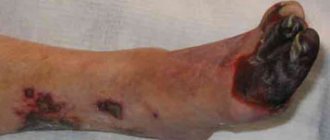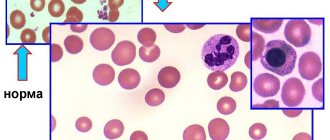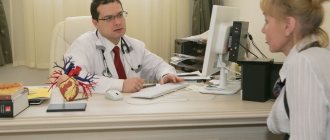© Author: A. Olesya Valerievna, candidate of medical sciences, practicing physician, teacher at a medical university, especially for SosudInfo.ru (about the authors)
Transposition of the great vessels (GV) is a severe cardiac anomaly when the aorta emerges from the right ventricle (RV) and the pulmonary trunk from the left. TMS accounts for up to 15-20% of all congenital heart defects (CHD); among patients there are three times more boys. TMS is one of the most common forms of congenital heart disease along with tetralogy of Fallot, coarctation of the aorta, ventricular septal defect (VSD), etc.
When the main arteries are transposed, the arterial blood is not enriched with oxygen, since it moves in a vicious circle, bypassing the lungs. The little patient becomes cyanotic immediately after birth, with obvious signs of heart failure. a defect with severe tissue hypoxia, requiring surgical treatment in the first days and weeks of life.
Causes of TMS
The exact reasons for the appearance of pathology in a particular baby are usually impossible to establish, because the mother could have been exposed to a variety of adverse effects during pregnancy. The following may play a role in the occurrence of this anomaly:
- Viral diseases during pregnancy (rubella, chickenpox, herpes, respiratory infections);
- Severe gestosis;
- Ionizing radiation;
- Consumption of alcohol, drugs with teratogenic or mutagenic effects;
- Concomitant pathology in a pregnant woman (diabetes, for example);
- The mother is over 35 years old, especially if this is the first pregnancy.
It has been noted that TMS occurs more often in children with Down syndrome, the causes of which are chromosomal abnormalities caused by the reasons listed above, among others. Children with TMS may also be diagnosed with defects of other organs.
There may be an influence of heredity, although the exact gene responsible for abnormal heart development has not yet been found. In some cases, the cause is a spontaneous mutation, while the mother denies the possibility of external influence in the form of x-rays, drugs or infections.
The formation of organs and systems occurs in the first two months of embryo development, so during this period it is necessary to protect the very sensitive embryo from all kinds of toxic factors. If the heart begins to form incorrectly, then it will not change, and signs of the defect will appear immediately after birth.
Treatment
Transposition of the great vessels can only be treated surgically! Before surgery, the child is prepared to alleviate the condition, which includes the following:
- drug therapy. The drug prostaglandin E1 (Alprostadil) helps to keep the duct open, which ensures adequate blood flow in the newborn for some time until the expected time of surgery;
- atrial septostomy, which specialists perform during cardiac catheterization. The essence of this procedure is to widen the hole in the interatrial septum. As a result, blood flow is ensured between the systemic and pulmonary circulation.
Surgery includes the following:
- arterial switching. This operation is carried out in the first months of the child’s life and consists in the fact that the specialist simply moves the aorta and pulmonary artery into place. If there are septal defects, they are sutured, but if the defect is small, then it can be left to heal;
- surgical intervention on the atria. A so-called tunnel is created between the two atria. As a result, blood and oxygen begin to flow into the lungs. As a result of the operation, the right ventricle begins to pump blood throughout the body. Complications of this intervention include disturbances in the functioning of the right ventricle and heart rhythm.
A person who has undergone surgery for transposition of the great vessels requires lifelong consultation with a cardiologist. Physical activity should be dosed. Also, to avoid infectious complications of the heart, a course of antibiotic therapy is required before any surgical or dental interventions. This applies to patients who have undergone arterial switch surgery.
So, transposition of the great arteries is a serious cardiac disorder that appears in fetal development. The disorder has a number of causes, among which hereditary predisposition can be noted. The pathological process requires qualified treatment, namely surgery. TMS cannot be treated with medication!
Blood movement during TMS
I would like to dwell in more detail on how blood moves through the cavities of the heart and vessels during their transposition, because without understanding these mechanisms it is difficult to imagine the essence of the defect and its manifestations.
Features of blood flow during TMS are determined by the presence of two closed, unconnected circulation circles. From a biology course, everyone knows that the heart “pumps” blood in two circles. These streams are separate, but represent a single whole. Venous blood leaves the pancreas into the lungs, returning as arterial blood enriched with oxygen to the left atrium. From the LV, arterial blood with oxygen enters the aorta and goes to the organs and tissues.
With TMS, the aorta begins not in the left, but in the right ventricle, and the pulmonary trunk arises from the left. Thus, we get two circles, one of which “drives” venous blood through the organs, and the second one sends it to the lungs and, in fact, receives it back. In this situation, there can be no talk of adequate exchange, since oxygenated blood does not reach other organs besides the lungs. This type of defect is called complete TMS.
Complete transposition in the fetus is quite difficult to detect. On ultrasound, the heart will appear normal, four chambered, with two vessels branching off from it. The diagnostic criterion for the defect in this case can be the parallel course of the main arteries, which normally intersect, as well as visualization of a large vessel that originates in the left ventricle and is divided into 2 branches - the pulmonary arteries.
It is clear that blood circulation is disrupted to a critical level, and it is impossible to do without at least some opportunity to send arterial blood to the organs. Strange as it may sound, other congenital heart diseases can come to the aid of a sick little heart. In particular, a defect in the septa between the atria or ventricles and an open ductus arteriosus will be beneficial. The presence of such additional communication routes makes it possible to connect both circles and ensure, albeit minimal, delivery of oxygen to the tissues. Additional pathways provide vital activity before surgery and are present in 80% of patients with TMS.
blood flow paths that are pathological for an adult partially compensate for the defect and are present in most patients
Of no small importance in relation to the clinic and prognosis is the state of the pulmonary blood flow, the presence or absence of its overload with blood. From this position, it is customary to distinguish types of TMS:
- With overload or normal pressure in the lungs;
- With reduced pulmonary circulation.
In nine out of ten patients, the small circle is overloaded with “excess” blood. The reasons for this may be defects in the septa, open ductus arteriosus, or the presence of additional communication routes. Depletion of the small circle occurs when the LV outlet is narrowed, which occurs in isolated form or in combination with a ventricular septal defect.
An anatomically more complex defect is corrected transposition of the great vessels. Both chambers and vessels are “confused” in the heart, but this makes it possible to compensate for disturbances in blood flow and bring it to an acceptable level. With corrected TMS, both ventricles with the vessels extending from them change places: the left atrium passes into the right ventricle, followed by the aorta, and from the right atrium the blood moves into the LV and pulmonary trunk. Such “confusion”, however, ensures the movement of fluid in the right direction and the enrichment of tissues with oxygen.
Complete TMS (left) and corrected defect (right), photo: vps-transpl.ru
In the case of a corrected defect, the blood will move in a physiological direction, so the presence of additional communication between the atria or ventricles is not required, and if it is present, it will play a negative role, leading to hemodynamic disorders.
Video: TMS – medical animation (eng)
Classification of the disease
Experts talk about several variants of the violation, namely:
- the vessels originate from only one ventricle, the left or the right. This happens when the arteries mistakenly switch their places and it turns out that one of the vessels comes out of both ventricles;
- complete transposition is characterized by a change in the pulmonary trunk and great vessels, due to which two circles of blood circulation appear;
- transposition of the highways leads to the appearance of additional heart defects, for example, septal defect;
- the corrected form, in fact, is distinguished by a double error: not only the vessels, but also the ventricles themselves have changed places.
Manifestations of TMS
During intrauterine development, this heart defect does not manifest itself in any way, because in the fetus the pulmonary circle does not work. After birth, when the baby’s heart begins to pump blood to the lungs on its own, TMS also manifests itself in full. If the transposition is corrected, then the clinical picture is poor; if the defect is complete, its signs will not be long in coming.
The degree of impairment with complete TMS depends on the communication pathways and their size. The more blood mixes in the heart in newborns, the more oxygen the tissues will receive. The optimal option is when there are sufficient holes in the septa, and the pulmonary artery is somewhat narrowed, which prevents volume overload of the pulmonary circle. Complete transposition without additional anomalies is incompatible with life.
Babies with transposition of the main vessels are born at term, with normal weight or even large, and already in the first hours of life signs of congenital heart disease are noticeable:
- Severe cyanosis of the whole body;
- Dyspnea;
- Increased heart rate.
Further, the symptoms of heart failure rapidly increase:
- The heart increases in size;
- Fluid appears in the cavities (ascites, hydrothorax);
- The liver enlarges;
- Swelling occurs.
Other signs of cardiac dysfunction are also noteworthy. The so-called “heart hump” (deformation of the chest) is caused by an enlargement of the heart, the nail phalanges of the fingers thicken, the baby lags behind in development, and does not gain weight well. Certain difficulties arise during feeding, since it is difficult for a child to suckle at the breast with severe shortness of breath. Any movement and even crying can be an impossible task for such a baby.
If an excess amount of blood enters the lungs, there is a tendency to infectious and inflammatory processes and frequent pneumonia.
The corrected form of TMS proceeds much more favorably. In the absence of other cardiac defects, clinical transposition may not occur at all, because the blood moves correctly. The child will grow and develop correctly according to his age, and the defect can be detected accidentally by the presence of tachycardia, heart murmur, or conduction disturbances.
If the corrected transposition is combined with other disorders, then the symptoms will be determined by them. For example, if there is a hole in the interventricular septum, shortness of breath will appear, the pulse will increase, and signs of heart failure will appear in the form of edema and enlarged liver. Such children suffer from pneumonia.
Symptoms
Transposition of the great arteries manifests itself in the form of the following symptoms, which indicate increasing hypoxemia:
- dyspnea;
- tachycardia;
- cyanosis of the skin;
- low weight gain due to lack of appetite.
In general, children with a pathological process are born full-term and of normal weight, and then almost immediately after birth, signs of oxygen starvation increase. If the transposition is combined with a PDA and coarctation of the aorta, then a characteristic symptom appears, in which cyanosis is more pronounced in the upper part of the body than in the lower.
Already in the first months from birth, the child develops symptoms of heart failure:
- cardiomegaly;
- hepatomegaly;
- ascites;
- peripheral edema.
When examining a child, specialists may find the following signs indicating transposition:
- deformation of the phalanges of the fingers;
- heart hump;
- malnutrition;
- delayed motor development.
If we talk about the corrected type of the pathological process, then its peculiarity is that for some time it is asymptomatic and the child develops as usual. When contacting a cardiologist, you can identify warning signs, including:
- heart murmurs;
- atrioventricular block;
- paroxysmal tachycardia.
If the operation is not performed in a timely manner during transposition of the great vessels, this may result in death.
Methods for correcting TMS
Considering the presence of anatomical changes in the heart, the only possible treatment option for the defect is surgery, and the sooner it is performed, the fewer irreversible consequences the disease will bring.
Emergency intervention is indicated for patients with complete TMS, and before surgery, prostaglandin drugs are prescribed to prevent the closure of the ductus arteriosus, which allows the blood to “mix.”
In the first days of a baby’s life, it is possible to perform operations to ensure the connection of the blood circulation. If there are holes in the partitions, they are expanded; if there are no defects, they are created. The Rashkind operation is performed endovascularly, without penetrating the chest cavity, and consists of inserting a special balloon that expands the oval window. This intervention provides only a temporary effect for several weeks, during which the issue of radical treatment must be decided.
The most correct and effective treatment is considered to be an operation in which the aorta returns to the left ventricle and the pulmonary trunk to the right , as they would be normally. The intervention is carried out openly, under general anesthesia, the duration is from one and a half to two hours or more, depending on the complexity of the defect.
example of surgery for TMS
After the baby is under anesthesia, the surgeon cuts through the chest tissue and reaches the heart. At this point, artificial blood flow is established, when the device plays the role of the heart, and the blood is additionally cooled to prevent complications.
Having opened the way to the main arteries and the heart, the doctor cuts off both vessels slightly above their attachment, approximately in the middle of their length. The coronary arteries are sutured at the mouth of the pulmonary artery, and then the aorta is “returned” here. The pulmonary artery is fixed to the portion of the aorta remaining at the exit from the right ventricle using a fragment of the pericardium.
The result of the operation is the normal arrangement of the vascular tracts, when the aorta leaves the left ventricle, the coronary arteries of the heart also begin from it, and the pulmonary trunk originates in the right half of the organ.
The optimal period for treatment is considered to be the first month of life. Of course, you can live longer waiting for her, but then the intervention itself will become inappropriate. As you know, the left ventricle is thicker than the right and is designed for greater pressure load. With a defect, it atrophies, as the blood is pushed into a small circle. If the operation is performed later than expected, the left ventricle will not be ready for the fact that it will have to pump blood into the systemic circulation.
When time is lost and it is no longer possible to restore the anatomy of the heart, there is another way to correct the blood flow. This is the so-called intra-atrial correction, which has been used for more than 25 years and has proven itself to be an effective method of treating TMS. It is indicated for children who did not undergo the above-described operation on time.
The essence of intra-atrial correction is to dissect the right atrium, remove its septum and sew in a “patch” that directs venous blood from the systemic circle to the left ventricle, from where it goes to the lungs, while the pulmonary veins return oxygenated blood to the “right” heart and then - into an abnormally located aorta. Thus, without changing the location of the main arteries, blood movement in the desired direction is achieved.
How is pathology diagnosed?
Breathing problems and cyanosis from the first minutes of a child's birth prompt the doctor to suspect a disorder. But you should understand that the disease can be insidious, for example, with the simultaneous development of other defects, cyanosis may not appear. So, with an atrial septal defect, a certain amount of blood, which is enriched with oxygen, still enters the systemic circulation.
If we note the growth processes of a child, then the transposition of the main arteries simply does not allow him to develop normally. This is because the circulatory system does not provide adequate blood flow of oxygenated blood.
The physical examination is complemented by other diagnostic methods, namely:
- blood test;
- A chest x-ray will help determine the size of the heart, as well as the position of the pulmonary artery;
- Echocardiography can detect the presence of other heart defects, as well as identify where the aorta and pulmonary artery originate;
- An ECG will provide information about the work of the heart, the condition of the ventricles, and will also identify existing rhythm disturbances;
- coronary angiography. The essence of this method is the introduction of a contrast agent using a catheter, after which X-ray images are taken.
Prognosis and treatment results
When a baby is born with transposition of blood vessels, his parents are very concerned about not only the operation, but also what will happen after, how the child will develop and what awaits him in the future. With timely surgical treatment, the prognosis is quite favorable: up to 90% or more of patients live a normal life, periodically visiting a cardiologist and undergoing a minimum of examinations to monitor the functioning of the organ.
With complex defects, the situation may be worse, but most patients still have an acceptable quality of life. After intra-atrial correction surgery, about half of the patients do not experience restrictions in life, and its duration is quite long. The other half may suffer from arrhythmias and heart failure, which is why it is recommended to limit physical activity, and women are warned about the risks during pregnancy and childbirth.
Today, TMS is a completely curable anomaly, and hundreds of children and adults who have successfully undergone surgery are proof of this. Much depends on the parents, their faith in success and desire to help their baby.
What is the prognosis for TMS?
If we talk about complete transposition, then this vice belongs to the category of critical and incompatible with life. If a child is not provided with timely specialized cardiac surgery, then fifty percent of children die in the first month of life. According to statistics, more than a third of babies die per year from hypoxia, circulatory failure and increasing symptoms of acidosis.
According to experts, in almost ninety percent of cases, good long-term results can be achieved with surgical correction. And if we talk about complex forms of the disease, then in 60-70 percent you can achieve positive results. After surgery, patients are advised to regularly consult a cardiac surgeon, limit intense physical activity, and prevent infective endocarditis.
Auscultation will help diagnose and detect heart pathology








